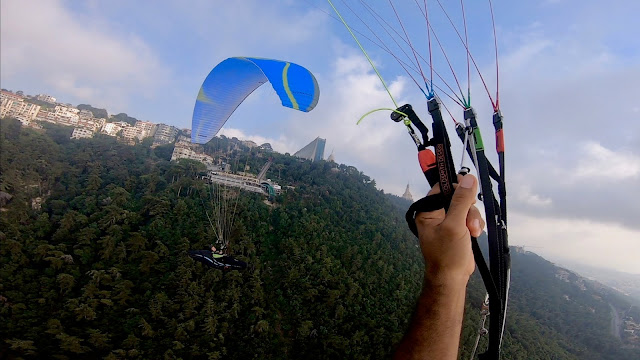ADVANCE Impress 4
As usual, I’m always impatient to test fly an ADVANCE harness. Simply because of that extraordinary quality of construction and exquisite finish that was made in their latest designs, and the Impress 4 is the ‘Chef-d'oeuvre’ example of what ADVANCE is offering.
For my 1.81 and 73 kg, the Impress 4 M suits perfectly my body shape, and felt well surrounded, and I can comment that I found it slightly bigger than the Genie light M, which I found myself at its max size potential. The Impress4 size M is similar to the Genie race4 M size, the Forza M, The Exoceat M, the Supair Delight 3 M.
It seems that the Impress 4 was fabricated on a very detailed and precise worksheet. I can speak for every detail as it seemed to be released upon a very serious study for its use. For example, the dashboard is large, very well in place, and could contain at least 3 instruments, with neat and proper holes for the wires that come from the power banks underneath which could be inserted in their respective pockets. Those details could be available in the new harnesses, but it seems that ADVANCE made them more efficient. The water release system (a large pocket at the left) is perfect as it is wide enough for inserting the urinating tube while flying if it got loose after running on take off. Lots and lots of small but efficient features. Two rescue containers, one anti G etc…you can find all those in the manual.
Now I like to talk about the back comfort. Sitting in the Impress 4 M with the seat-board feels around 90 % as sitting in the Impress 3 in terms of back comfort ! which is very high for a seat board harness, and probably the only most comfortable seat harness for the back and hip till date. The legs are naturally supported, and the feel is like sitting in your favorite couch in front of the TV! So relaxing to sit in. Getting in and out is as easy as it gets.
All the adjustments are very easy to access in the air, as I could easily adjust them to my liking.
Now about the roll movement on the Impress 4. Having flown the Impress 2 and impress 2 plus and also the Impress 3, I could describe what you will feel inside the Impress4.
In roll feel and weight shift control, with the ability of counter-steering rough corners, the Impress 4 sits between the Impress 2 plus and the impress 3, with a slight move toward the Impress 2+ on the seat feel, having also some slight spongy feel of the Impress3. That’s the best way I could describe it to you.
So, it’s easy, and I could feel the seat board, but not as ‘edgy’ or ‘ authority to (lock your thigh on a seat board) as the Impress 2+, Genie light 3, X-rated6, Genie race 4, for example, but good enough!
I have to add that even if you pull the front strap adjustment that lifts your knees, the feel remains slightly less. And also your legs would not be naturally supported anymore. So it's best to sit comfortably, with legs supported, and acclimatize yourself with the Impress 4 feel.
Saying that the Impress 4 could be the best harness to date to offer that extra mix of feelings. Lots of pilots would love to get a harness with less edge or ‘direct, straight’ lift from the seat board edge, and some would prefer that edge. It is always a matter of personal taste. Many pilots on the Impress3 would be very happy on the Impress4 as it seems to offer ‘best of both worlds’ seat and seatless harness feel even with at the seat board in!
Having flown the harness without a seaboard, I personally would stick to the seat board as it's my personal preference.
One thing I have to say is that when I fly my X rated 6 after some hours, and after landing, my body parts (feet, hips, etc) feel and stress a bit the movements that were present in that flight. On the Impress 4 with some rough air, my body was still comfortable enough after landing.
Conclusion: The Impress4 looks like an improved, very well made harness, and a much more detailed and neat version of my X-rated 6 with much better comfort for the back. The feedback that comes from the glider has slightly less authority to counter-steer than the X rated6, but probably well enough to be satisfied. I only wished that the magnet that prevents the pod from opening while weight-shifting, would be slightly bigger. The ballast under the seat is small. That’s it.
ADVANCE produced a very comfortable, very well made, impressive-looking harness with the smallest thinkable details.





















